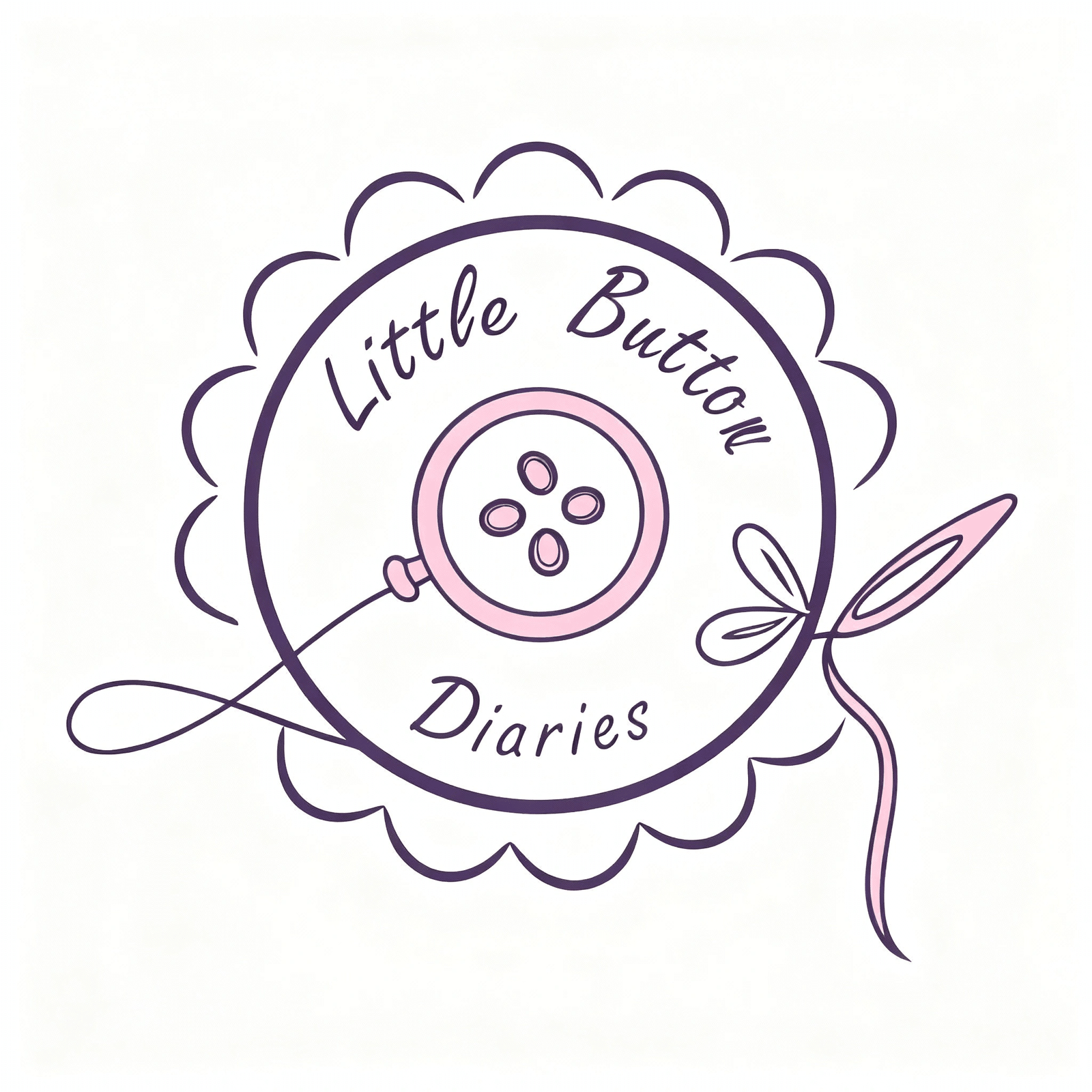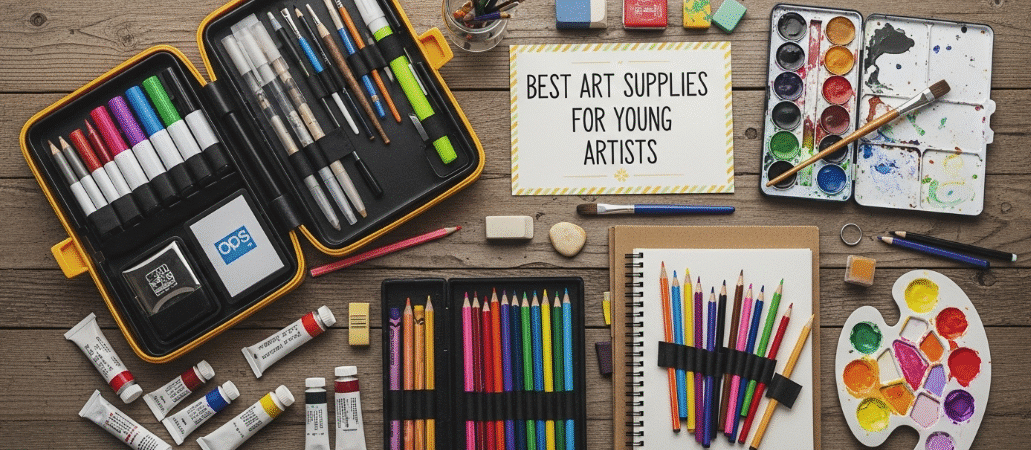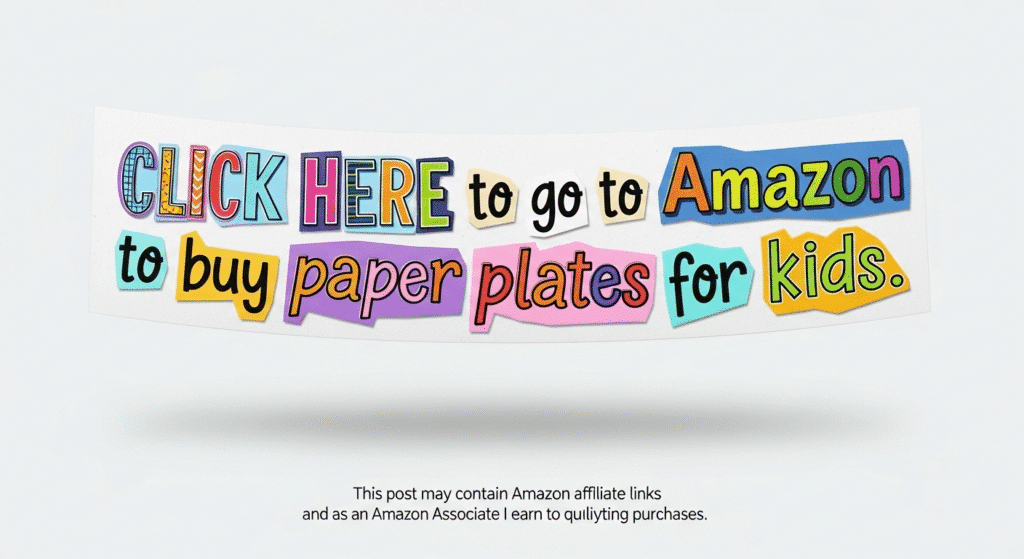If you’re looking for the best art supplies for young artists, you’re in the right place. Helping kids get their hands on the right tools can make a big difference in how much they enjoy creating. Whether your little one is just starting out or already loves to draw and paint, having the right materials can keep their imagination flowing and their skills growing.
We hope these recommended art supplies will inspire creativity and bring joy to every young artist.
- Why Do Good Supplies Matter ?
- Which Paper is Best for Young Artists ?
- Making Ideas Come to Life with Drawing Tools
- Bringing out the Big Brushes and Paints for Watercolour Fun
- Developing Skills with Watercolor Pencils
- Glue, Scissors & Other Craft Supplies – The Fun Stuff
- Keeping Art Supplies Organised
- Encouraging Creativity in Kids and Families
- Tips for Choosing Supplies That Fit Your Child
- Growing a Collection That Grows with Your Artist
- Final Thoughts
Why Do Good Supplies Matter ?
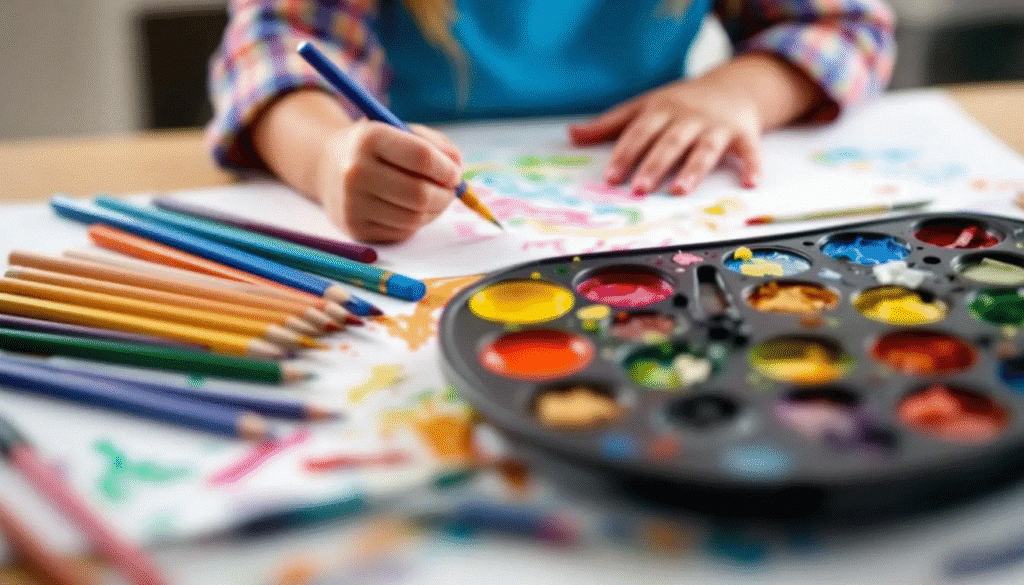
When kids have access to decent quality supplies, they get to explore colours, textures and shapes in a way that’s actually fun. Plus, using the right tools helps them learn new skills like mixing colours, blending shades and making patterns – it’s not just about making art, it’s about building confidence and nurturing their creativity.
Which Paper is Best for Young Artists ?
Paper is the foundation of most art projects, so getting the right kind is a no-brainer. Drawing and watercolor paper come in various sizes to suit different projects and preferences. Drawing paper works well for pencils, crayons and markers. If your little one is keen on painting, especially watercolour painting, you should look for watercolour paper. Cold press watercolour paper is a popular choice because it’s got a lovely texture that holds paint really well without being too rough. It’s a great option for kids who want to experiment with different painting techniques.
Making Ideas Come to Life with Drawing Tools
Coloured pencils and crayons are old favourites for young artists. They’re easy to use, fun and perfect for everything from doodling to detailed drawings. If you want more control and bolder colours, markers are a versatile addition. Pens, such as fineliner pens or gel pens, are also great for adding fine details to drawings. Chunky crayons or jumbo colored pencils are easy for small hands to grip, making them ideal for younger children. When choosing, make sure to go for non-toxic markers and crayons – you know, for peace of mind.
Watercolour pencils are another fun tool to add to the mix. They let kids draw with colour pencils and then blend the colours with water to get some really cool effects. It’s a neat way to combine drawing and painting in one go.
Bringing out the Big Brushes and Paints for Watercolour Fun
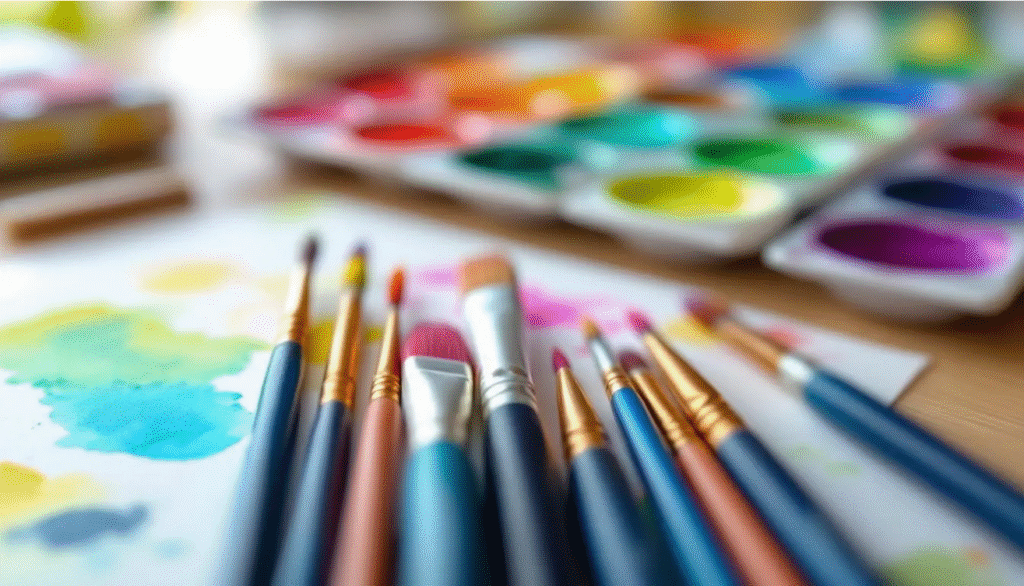
Watercolour brushes come in all shapes and sizes—it’s great to have a few different ones, including small, medium, and large brushes, so your kids can experiment with thin lines, wide strokes, and everything in between. Large-grip brushes are easier for little hands to maneuver, making them a great choice for younger artists. When they’ve got good brushes and decent quality watercolour paper, they can see their colours mix and flow in a really magical way.
Tempera paint is another favourite among young artists. It dries fast, is easy to clean up and comes in loads of bright, vibrant colours. Tempera paints deliver a vibrant, opaque finish and are fast-drying, making them essential for young artists. It’s perfect for all sorts of crafts and projects, from simple paintings to more textured work. Watercolors are also a popular choice, offering a wide range of blending and layering possibilities for creative exploration.
Developing Skills with Watercolor Pencils
If you’re after a brilliant and dead-simple way to get the kids into art, then watercolor pencils are a top pick. These clever little tools are a cracking combination of coloured pencils and watercolor painting all rolled into one – you can draw fine lines just like with regular pencils, then grab a wet brush and watch the magic happen as everything blends into gorgeous, painterly effects. For little ones who love to have a go at different things, watercolor pencils open up a whole world of creative possibilities right there at the kitchen table.
When you’re picking out watercolor pencils for the kids, you’ll want to look for non-toxic ones that can handle plenty of bashing about and play. Sets with loads of different colours are brilliant – gives the young artists the freedom to have a proper go at colour mixing and create their own unique shades. Brands like Faber-Castell, Derwent, and Caran d’Ache are known for being top quality and lasting ages, so they’re a smart choice whether you’ve got beginners or kids who’ve already got the hang of things.
To get the best results, you’ll want to pair those watercolor pencils with cold press watercolor paper or some sturdy drawing paper. Cold press paper, with its lovely gentle texture, helps keep the colours nice and vibrant and lets everything blend smoothly without the paper going all wonky. Starting with light layers and gradually building up the colour is the way to go – this keeps the paper from getting too soggy and makes sure the colours stay bright and clear. Get the kids to try different pencil strokes, like hatching or cross-hatching, to add some proper texture and patterns to their paintings.
Watercolor pencils are also dead good for mixed-media projects. The kids can use glue sticks to pop on cut-out shapes or mix their watercolor drawings with regular coloured pencils for extra detail and shading. This sort of creative mucking about not only makes their art look brilliant but also builds up their confidence and gets their imagination going.
For teachers and parents, watercolor pencils are just the thing for getting little ones interested in art and helping them pick up new skills. Whether your child’s just starting to draw or already loves having a go at painting, these pencils give you loads of opportunities for fun, learning, and creative expression. With the right supplies and a bit of encouragement, every young artist can knock up vibrant, one-of-a-kind paintings that’ll have the whole family chuffed to bits.
Glue, Scissors & Other Craft Supplies – The Fun Stuff
Art isn’t just about drawing and painting – glue sticks and safety scissors are essentials for cutting, pasting and putting together all sorts of creative projects. Glue sticks or non-toxic liquid glue, child-safe scissors, and stickers are great for crafting. Stickers and colorful paper add fun details that can turn a simple drawing into a full-on masterpiece.
Many craft kits come filled with a variety of materials, making them perfect for creative projects.
Having a good supply of glue sticks makes it easy for kids to work on collages and mixed media crafts. Safety scissors help little hands cut out shapes and patterns without worrying about hurting themselves.
Many art supplies are available in a convenient package, making them easy to gift or store.
Keeping Art Supplies Organised
Getting your art materials organised helps your kids focus on creating rather than hunting for supplies. Using bins, baskets or a small bag to hold pencils, markers and brushes keeps everything tidy and ready to use. Blue Ginko Caddies are perfect for storing markers, pencils, scissors, and glue on an art table or desk. Having a dedicated art table or corner makes a big difference too – it gives your kids a special place to create and store their work.
Encouraging Creativity in Kids and Families
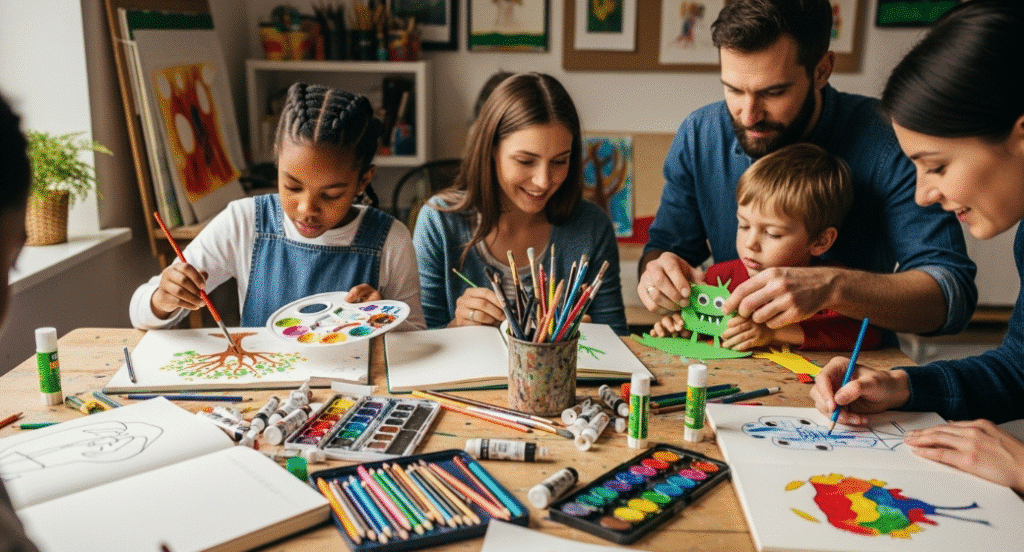
Art is a brilliant way for kids to express themselves and share their ideas. Many art supplies and projects are enjoyable for adults as well, making art a fun activity for all ages. It’s also a great way for families to spend quality time together trying out new projects and crafts. Whether it’s drawing, painting or making simple crafts, having the right supplies on hand means there’s always something fun to do.
Tips for Choosing Supplies That Fit Your Child
Every young artist is different – some like drawing detailed pictures, others prefer bold colours and messy painting. Look for supplies that match your child’s interests and skill level. Don’t worry if you need to try a few different things to find the perfect fit.
When you’re shopping for art supplies, make sure to check for non-toxic labels and recommended ages so you can be sure everything is safe and suitable. Buying sets that include a variety of tools can be a great way to stock up a supply kit without breaking the bank.
Growing a Collection That Grows with Your Artist
As your child’s skills develop, their art supplies can grow too. Adding sketchbooks, watercolour pencils and more advanced brushes gives them new ways to create. Keeping a collection of supplies ready to go means your young artist can always try new projects.
As their interests and skills develop, parents and young artists can shop together for new art supplies to expand their collection.
Final Thoughts
Choosing the best art supplies for young artists doesn’t have to be a difficult challenge. With a few key tools like good paper, colourful pencils, safe paints and craft basics, kids have everything they need to enjoy art and develop their skills. Many of these art supplies are perfect for school projects and classroom use, making them practical for both home and school environments. Creating a space for art and keeping supplies organised makes the whole process even more fun. Most of all, the right supplies help kids feel free to imagine, create and share their unique ideas every single day. Remember, there is no wrong way to be creative—encourage kids to explore and experiment freely.
